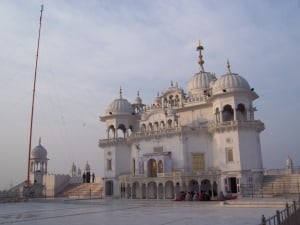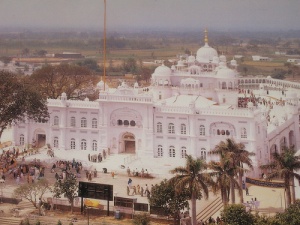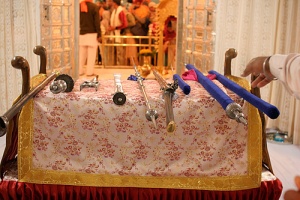Gurdwara Keshgarh Sahib: Difference between revisions
SinghKalsi (talk | contribs) No edit summary |
No edit summary |
||
| (11 intermediate revisions by 4 users not shown) | |||
| Line 1: | Line 1: | ||
[[Image: | [[Image:keshgarhsaabb.JPG|thumb|300px|right|Keshgarh Sahib]] | ||
''' | '''Gurdwara Shri Keshgarh Sahib''' {{coord|31.235169|n|76.499128|e}} is located in the center of the city of [[Anandpur Sahib]], [[Punjab]], [[India]]. It is also known as '''''"Takht Shri Keshgarh Sahib"''''' and is one of five highest Sikh institutions in [[India]]; it is the city's main Sikh shrine. The city began as Chakk Nanaki, which was founded by [[Guru Tegh Bahadur]] Ji in [[1665]]. His son, [[Guru Gobind Singh ji]], who spent 25 years of his life in the city, added greatly to the city's size, giving it the new name, “City of Bliss (Anandpur).” | ||
Its foundation stone was laid on March 30, 1689. In fact, it was here that the [[Khalsa]] Panth was born with the first initiation of [[Khande Di Pahul]], when the young Guru called for a special congregation on the [[Baisakhi day]] of [[1699]] with thousands of [[Sikh]]s in attendance. One can only imagine how large the area was around Sri Keshgarh Sahib then to accommodate the many thousands of Sikhs in attendance on that historic day. | |||
[[ | |||
==Background== | |||
[[Image:Keshgarh_Sahib.jpg|thumb|300px|right|Keshgarh Sahib]] | |||
At that time, the hill of Sri Keshgarh Sahib was at least 10-15 feet higher than it is today. Next to it there was, at that time, another hill known as "Tambu (tent) Wali Pahari", because a special tent was set up there on the day of the revelation of the Khalsa Panth. That hill and a long range of small hills which extended from Sri Kesgarh Sahib to Anandpur fort no longer exist, because in the name of progress, in 1973, a road was constructed to link the Sri Kesgarh Sahib and Sri Anandgarh Sahib fort that necessitated leveling the hill tops. | |||
The Sri Keshgarh Sahib fort was built in [[1699]]. The neighboring hill armies attacked Sri Anandpur Sahib several times between 1700 and 1705, but were never able to reach Sri Kesgarh Sahib because the fort was seemingly impregnable and besides, before reaching the gates of Kesgarh, the armies would have had to capture the forts at Taragarh, Agamgarh, Fatehgarh, and Anandgarh, and that never happened. | |||
==Departure of Anandpur Sahib== | |||
It was only after the half starved occupants of the city and its defensive forts, convinced Guru Sahib to agree to leave the city, under the promise of safe passage from their attackers. It was only when the great Guru and his Sikhs were about to forge a nearby river, that the hill armies entered the fort and began to demolish it. | |||
The Sikhs were unable to return to Anandpur Sahib until [[Baba Banda Singh|Baba Banda Singh's]] efforts to retake the city proved successful. Banda Bahadur also subjugated the ruler of Bilaspur, who had been behind the siege of the city in 1705. But all to soon the Sikhs had to face another wave of persecution after the fall of Baba Banda Singh. | |||
==Anandpur becomes prosperous again== | |||
Within the next ten years most of the Sikh homeland was once again under the rule of Sikhs. With Maharaja Ranjit Singh, the other Sikh Misls and the Patiala dynasty, becoming the de facto rulers of Punjab, a period of peace and prosperity allowed the scattered Sikhs to begin making frequent visits to Anandpur Sahib. Anandpur Sahib became the safest place for Sikhs. Baba Baghel Singh of the Karorasinghia Misl, who had taken charge of Delhi and constructed many Sikh shrines in the city, visited Anandpur Sahib in the 1780s and decided to construct, repair and renovate the shrines of the city. | |||
In 1812, Mahan Chand, the ruler of Bilaspur, attacked Anandpur Sahib only to suffer heavy losses. | |||
==One of five takhats== | |||
[[Image:Shastars.jpg|thumb|300px|right|Shastars of Guru Gobind Singh Ji and His Warriors]] | |||
Shri Keshgarh Sahib is one of the Five [[Takhat]]s or 'Seats of Authority' of the [[Sikh]]s. | |||
Kesgarh Sahib is the home of many historical relics (Pictures in Photo Gallery) which belonged to Shri [[Guru Gobind Singh]] ji. These include the actual Khanda (double edged sword) that the Guru used to prepare amrit on the revelation of Khalsa Day, a Kataar, Guru Gobind Singh's personal dagger (which he always carried), a saif (a double edged weapon presented to the Guru by Mughal Emperor Bahadur Shah) and a beautiful gun that was presented to Guru Sahib by one of his sikhs from Lahore. | |||
After 1820 regular Granthis began serving at Kesgarh Sahib. Historical sources mention the names of Bhai Karam Singh, Bhai Kharak Singh, Bhai Budh Singh, Bhai Puran Singh, Bhai Amar Singh etc as the Granthis of Kesgarh Sahib. For about a century (1820 to 1925) Kesgarh Sahib had only one Granthi, but after Gurdwara reform movement (1920-25) a "Jathedar" was appointed here too. This designation was given to Giani Resham Singh, Giani Partap Singh Mallewal, Jathedar Bir Singh, Master Ajit Singh Ambalvi, Giani Fauja Singh, Giani Bachitar Singh, Jathedar Gurdial Singh Ajnoha, Jathedar Harcharan Singh Mahalon, Bhai Shawinder Singh, Bhai Balbir Singh, Bahi Manjit Singh (Prof.) etc. | |||
{{takhats}} | |||
==The present buildings == | |||
The present complex was constructed during 1936-44 under the supervision of Sant Hari Singh Kaharpuri. Being on a slope, the complex has two levels protected by retaining walls on the sides. On the lower level, approached by a flight of steps is the imposing two-storeyed gateway, offices, and a 30-metre square courtyard. | |||
The level on which stands the main building is 2.5 metres higher than the courtyard. The 16-metre square hall with a balcony in front contains within it the sanctum, a 5.5-metre square room in which some old weapons preserved as sacred relics from the time of Guru Gobind Singh are displayed on a low platform. | |||
The Guru Granth Sahib is seated under a canopy outside the sanctum, above which rises a fluted lotus dome topped by a tall ornamental pinnacle of gilded metal, and a gilded khanda as a finial. On the roof, corners of the hall and the balcony are adorned with domed kiosks. | |||
==New langar hall completed in 2011== | |||
The original Guru ka Langar was on the lower level behind the central building. However, a new multi-level building was built adjacent to the main Gurdwara and in the space next to the "Sri Guru Tegh Bahadur Nivas". | |||
The lower slopes of the Kesgarh hill are covered with rows of residential rooms for staff and pilgrims. This complex is collectively known as Dashmesh Nivas. A 55-metre square divan hall, about 150 metres east of the central building, was added during the 1980's to cater for large congregations on festival occasions. | |||
A sarovar bathing tank, 80-metre square, in a walled compound is situated at ground level to the west of the Takht Sahib and close to the Ropar-Nangal road. The relics placed in the inner sanctum of Takht Sri Kesgarh Sahib include a khanda, a katar (dagger), a saif (double-edged straight tapering sword), a muzzle-loading musket, a spear known as karpa barchha, and a nagani (a kind of spear with a twisted and pointed blade). | |||
Another set of weapons also believed to have once belonged to Guru Gobind Singh, which had been taken away by the British to England after the occupation of the Punjab in 1849 and which were returned in time for the celebration of the 300th birth anniversary of Guru Gobind Singh in 1966-67 are now on display here. | |||
==See also== | |||
* [[Six forts of Anandpur sahib]] | |||
==External links== | |||
* [http://www.flickr.com/photos/hari_singh/sets/72157603877771440/ Photos of this Gurdwara] | |||
[[Category:Gurdwaras in Ropar District]] | [[Category:Gurdwaras in Ropar District]] | ||
Latest revision as of 16:00, 31 August 2018
Gurdwara Shri Keshgarh Sahib is located in the center of the city of Anandpur Sahib, Punjab, India. It is also known as "Takht Shri Keshgarh Sahib" and is one of five highest Sikh institutions in India; it is the city's main Sikh shrine. The city began as Chakk Nanaki, which was founded by Guru Tegh Bahadur Ji in 1665. His son, Guru Gobind Singh ji, who spent 25 years of his life in the city, added greatly to the city's size, giving it the new name, “City of Bliss (Anandpur).”
Its foundation stone was laid on March 30, 1689. In fact, it was here that the Khalsa Panth was born with the first initiation of Khande Di Pahul, when the young Guru called for a special congregation on the Baisakhi day of 1699 with thousands of Sikhs in attendance. One can only imagine how large the area was around Sri Keshgarh Sahib then to accommodate the many thousands of Sikhs in attendance on that historic day.
Background
At that time, the hill of Sri Keshgarh Sahib was at least 10-15 feet higher than it is today. Next to it there was, at that time, another hill known as "Tambu (tent) Wali Pahari", because a special tent was set up there on the day of the revelation of the Khalsa Panth. That hill and a long range of small hills which extended from Sri Kesgarh Sahib to Anandpur fort no longer exist, because in the name of progress, in 1973, a road was constructed to link the Sri Kesgarh Sahib and Sri Anandgarh Sahib fort that necessitated leveling the hill tops.
The Sri Keshgarh Sahib fort was built in 1699. The neighboring hill armies attacked Sri Anandpur Sahib several times between 1700 and 1705, but were never able to reach Sri Kesgarh Sahib because the fort was seemingly impregnable and besides, before reaching the gates of Kesgarh, the armies would have had to capture the forts at Taragarh, Agamgarh, Fatehgarh, and Anandgarh, and that never happened.
Departure of Anandpur Sahib
It was only after the half starved occupants of the city and its defensive forts, convinced Guru Sahib to agree to leave the city, under the promise of safe passage from their attackers. It was only when the great Guru and his Sikhs were about to forge a nearby river, that the hill armies entered the fort and began to demolish it.
The Sikhs were unable to return to Anandpur Sahib until Baba Banda Singh's efforts to retake the city proved successful. Banda Bahadur also subjugated the ruler of Bilaspur, who had been behind the siege of the city in 1705. But all to soon the Sikhs had to face another wave of persecution after the fall of Baba Banda Singh.
Anandpur becomes prosperous again
Within the next ten years most of the Sikh homeland was once again under the rule of Sikhs. With Maharaja Ranjit Singh, the other Sikh Misls and the Patiala dynasty, becoming the de facto rulers of Punjab, a period of peace and prosperity allowed the scattered Sikhs to begin making frequent visits to Anandpur Sahib. Anandpur Sahib became the safest place for Sikhs. Baba Baghel Singh of the Karorasinghia Misl, who had taken charge of Delhi and constructed many Sikh shrines in the city, visited Anandpur Sahib in the 1780s and decided to construct, repair and renovate the shrines of the city.
In 1812, Mahan Chand, the ruler of Bilaspur, attacked Anandpur Sahib only to suffer heavy losses.
One of five takhats
Shri Keshgarh Sahib is one of the Five Takhats or 'Seats of Authority' of the Sikhs.
Kesgarh Sahib is the home of many historical relics (Pictures in Photo Gallery) which belonged to Shri Guru Gobind Singh ji. These include the actual Khanda (double edged sword) that the Guru used to prepare amrit on the revelation of Khalsa Day, a Kataar, Guru Gobind Singh's personal dagger (which he always carried), a saif (a double edged weapon presented to the Guru by Mughal Emperor Bahadur Shah) and a beautiful gun that was presented to Guru Sahib by one of his sikhs from Lahore.
After 1820 regular Granthis began serving at Kesgarh Sahib. Historical sources mention the names of Bhai Karam Singh, Bhai Kharak Singh, Bhai Budh Singh, Bhai Puran Singh, Bhai Amar Singh etc as the Granthis of Kesgarh Sahib. For about a century (1820 to 1925) Kesgarh Sahib had only one Granthi, but after Gurdwara reform movement (1920-25) a "Jathedar" was appointed here too. This designation was given to Giani Resham Singh, Giani Partap Singh Mallewal, Jathedar Bir Singh, Master Ajit Singh Ambalvi, Giani Fauja Singh, Giani Bachitar Singh, Jathedar Gurdial Singh Ajnoha, Jathedar Harcharan Singh Mahalon, Bhai Shawinder Singh, Bhai Balbir Singh, Bahi Manjit Singh (Prof.) etc.
| Five Takhats Of Sikhism |
|
Shri Akal Takhat • Takhat Sri Keshgarh Sahib • Takhat Sri Patna Sahib • Takhat Sri Hazoor Sahib • Takhat Sri Damdama Sahib |
The present buildings
The present complex was constructed during 1936-44 under the supervision of Sant Hari Singh Kaharpuri. Being on a slope, the complex has two levels protected by retaining walls on the sides. On the lower level, approached by a flight of steps is the imposing two-storeyed gateway, offices, and a 30-metre square courtyard.
The level on which stands the main building is 2.5 metres higher than the courtyard. The 16-metre square hall with a balcony in front contains within it the sanctum, a 5.5-metre square room in which some old weapons preserved as sacred relics from the time of Guru Gobind Singh are displayed on a low platform.
The Guru Granth Sahib is seated under a canopy outside the sanctum, above which rises a fluted lotus dome topped by a tall ornamental pinnacle of gilded metal, and a gilded khanda as a finial. On the roof, corners of the hall and the balcony are adorned with domed kiosks.
New langar hall completed in 2011
The original Guru ka Langar was on the lower level behind the central building. However, a new multi-level building was built adjacent to the main Gurdwara and in the space next to the "Sri Guru Tegh Bahadur Nivas".
The lower slopes of the Kesgarh hill are covered with rows of residential rooms for staff and pilgrims. This complex is collectively known as Dashmesh Nivas. A 55-metre square divan hall, about 150 metres east of the central building, was added during the 1980's to cater for large congregations on festival occasions.
A sarovar bathing tank, 80-metre square, in a walled compound is situated at ground level to the west of the Takht Sahib and close to the Ropar-Nangal road. The relics placed in the inner sanctum of Takht Sri Kesgarh Sahib include a khanda, a katar (dagger), a saif (double-edged straight tapering sword), a muzzle-loading musket, a spear known as karpa barchha, and a nagani (a kind of spear with a twisted and pointed blade).
Another set of weapons also believed to have once belonged to Guru Gobind Singh, which had been taken away by the British to England after the occupation of the Punjab in 1849 and which were returned in time for the celebration of the 300th birth anniversary of Guru Gobind Singh in 1966-67 are now on display here.



